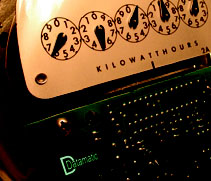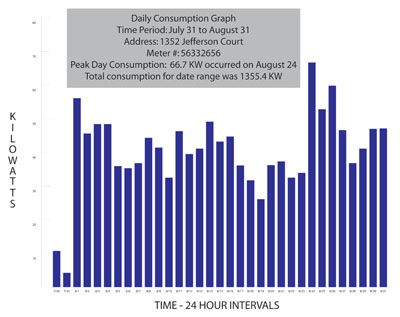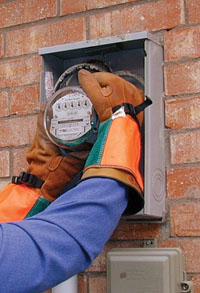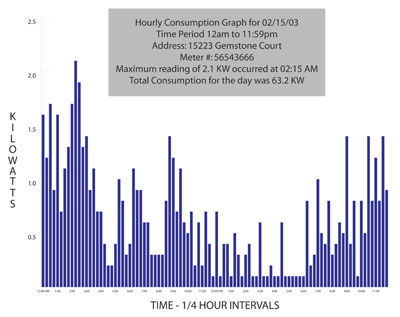Utilities want data, especially about when and how much energy is being used. Traditionally, the acquisition of that data has been accomplished with expensive commercial and industrial (C&I) meters that enable satellite, Internet, cellular, RF or modem transmission of usage data back to the utility. There has also been the ability to retrieve this data through expensive power line carrier (PLC) equipment and the expansive substation infrastructure that goes with it. However, this method presents an additional problem of needing to collect and store data for all endpoints on a constant basis.
The Options
The continuous reduction in the cost of non-volatile memory has enabled the capability to collect and store large amounts of this interval data at the meter—until the utility is ready to use it-- for right sizing transformers, customer service and billing issues, load studies, TOU billing and any number of other uses. The automatic collection and storage of desired data at every meter provides the flexibility for the utility to retrieve and use the data when and how they want, without the overhead and expense of alternative systems and specially skilled personnel. The downside is that most utilities do not have telecommunications expertise or communications infrastructure experience; they also are not usually equipped to provide effective data storage and network management.
There are limitations to traditional drive-by methods of meter reading and data collection that only collect a monthly cumulative read versus a Fixed Network (FN) method of collection. Here, “Fixed Network” refers to both the power line carrier fixed network and the wireless RF fixed networks. Many FNs, including some of the new power line carrier technologies, offer real-time or near real-time two-way communications. For some utilities the added expense of purchasing a FN solution with this two-way capability, particularly when coupled with a remote on/off control feature, has been worth the cost.
Another virtue of FN solutions is the availability of outage notification. Many FN systems can provide timely outage notification that indicates the location of the outage. For some utilities, the high expense outweighs the value of these features.
For most utilities, especially those with large industrial bases, a large percentage of revenue comes from a small percentage of customers. To address the needs of these customers, many utilities install meters that will collect and store data. The data is then collected during monthly meter readings via optical probing.
A few more advanced meters can transmit some of that data back to the utility at various intervals via connection methods like POTS (plain old telephone service) lines, satellite, TCP/IP, etc. This allows high use customers options like web-based, real-time energy usage management tools or interactive TOU billing. The high end C&I meters can provide utilities with the “when” and “how much” answer to the question of energy usage, but they are prohibitively expensive for all but the highest revenue generating customers.
Weighing the Costs
Cost has been the prohibitive factor to offering a data logging or data collection type of functionality on every meter. Since the cost of non-volatile memory (generally what is used to store the collected data) has dropped significantly over the years, it has become substantially less expensive to add or, in the case of some pioneering companies that already offer this profiling ability, to increase the data logging and storage capabilities for the meter interface units (MIU).
Common examples of how much the cost of non-volatile memory has decreased over the years in the retail market include compact flash cards for MP3 players, digital cameras and PDA storage. The cost of the new key ring style USB hard drives also continues to drop (or rather the amount of storage offered for the same price increases). These are both non-volatile memory devices, and as an example the 128 MB (megabyte) compact flash card that would have cost $150 18 months ago, now costs as little as $40.
An AMR based example can be seen with one AMR vendor’s second revision of their gas meter MIU. Their collected data storage capacity went from 74 days worth of data to 330 days, with no increase in the cost of the MIU itself.
Alternatives
Most utilities have purchased, evaluated or at least inquired about AMR systems over the years. The Scott Report shows a continuing increase year over year in the number of AMR MIUs being installed by electric, water and gas utilities. Utilities that haven’t already done so will put together cost benefit analyses that review FN AMR as well as drive-by AMR. The primary purpose of these evaluations will focus on reducing the cost of getting the read. RF based FN solutions will substantially reduce the cost of reading the meter but the infrastructure build out is costly.
Carolyn Kinsman of Automated Communications Links, an Ontario, Canada, based utility consulting firm, estimates that AMR costs for basic systems is dropping at approximately 5-7% per year. Cost justification for basic systems is more easily obtainable due to this reduction and the ability to quantify more benefits directly attributed to AMR.
The expense and complexity of purchasing and operating a FN solution doesn’t have to keep a utility from getting the data that will allow them to function more effectively or provide a higher level of customer service. Inversely, the desire to have data that will allow a utility to function more effectively or provide a higher level of customer service shouldn’t force them to spend the added cost for a FN if it doesn’t make sense.
Drive-by AMR MIUs are currently on the market today that allow utilities to collect interval data with a resolution as fine as every 5 minutes and allow for storage of 15-minute interval data, in the case of at least one vendor, for up to 84 days. While 84 days may not sound very impressive when gas units can store 330 days worth of data, the difference is the resolution. For gas applications, the interval data is generally collected hourly, where as in electric metering applications, the resolution is typically every 15 minutes. The number of days that can be stored in a device is a function of the interval data resolution, the amount of data for each interval being stored and total memory capacity.
Storing the Information
The significance of the data being stored in non-volatile memory is that when the power goes out or the battery dies (in the case of a gas or water MIU), the information stored in non-volatile memory will not be lost. In many other forms of memory, a constant source of power is required for it to maintain its internal information.
The significance to the utility is twofold. First, it is important to ensure that the memory in the MIU selected is non-volatile and uses a FIFO (first-in, first-out) method of data management so the most recent data is retained. Secondly, it is critical to make sure that the electric meter MIU has a battery back-up. In cases where the MIU is powered from the meter, the battery back-up is present so the MIU can continue to record interval data and log the times during a power outage. Without a battery back-up, the interval data cannot be continuously maintained; this would keep a utility from getting accurate outage information as well as prevent being able to do any sort of TOU billing since the time accounting would be thrown off every time there is an outage.
Collecting the Data
Now the data is stored in the meter. There are a few methods of retrieval available for AMR systems. All include some level of active communication.
Optically probing is an option that many utilities are familiar with already, but optical probing is a manual process. A more effective method is to retrieve data wirelessly using a local RF connection, such as an RF enabled field computer or vehicle based RF drive-by collection device that would be able to query selected meters for the stored interval data in conjunction with the standard drive-by read information. “Local” is stressed to illustrate that it would not be a long range RF transmission, otherwise some sort of a FN infrastructure would be needed.
An obvious question would be if the data resides in all the meters and can be retrieved wirelessly then why isn’t all the data just sent each time a reading is taken? The answer lies in the amount of data that is being transmitted. While driving down the road with a mobile receiver and collecting meter reads, collection personnel can do so and keep moving at a reasonable speed because the amount of data in a typical meter reading being sent is small, on the order of a few hundred bytes. A typical usage profile data set is on the order of 4K to 8K bytes. The most effective way to collect this data is wirelessly retrieving it during the course of standard drive-by reading from strategically selected accounts. Profile data is not collected every month from every meter.
Knowledge is Power
Now that the data is there and available, what can be done with it? With the right data management the uses are limited by the utilities innovativeness and imagination.
The key words are “right data management". One of the values of having data stored at the meter is so it can be retrieved and used when needed; therefore, only needs to be managed as it is selectively collected.
It is critical to ensure an AMR vendor has a very flexible package for viewing and manipulating the data once it is collected. Virtually all AMR vendors currently have some number of canned reports inside of their route management/data management software. Utilities should look at least two steps beyond this to effectively manage the profile or interval data that is being collected at the meter. This means being able to customize the reports within the vendor’s software without undue additional expense. Additionally, it would be important to have a “save as” type of functionality that allows the user to save collected data into some other externally manageable format such as ASCII text, delimited, CSV, .xls, etc.
Common uses for profile data include peak demand studies, TOU billing, right sizing transformers, customer dispute resolution, theft monitoring and enhanced customer service. Users should never let the historical uses or ‘groupthink’ keep them from using locally stored, easily retrieved and simply manipulated data in new and cost saving, customer serving ways.
The Bottom Line
The need for energy use data can now be met due to the lower MIU costs, advances in technology and new profiling options. Utilities can now choose a cost effective AMR system that gives them the data they need to provide a higher level of customer service and better understand where and when their energy is being used. This information will lead to more effectively managing infrastructure build out, load management and customer service all without having to build and manage an expensive network infrastructure. Utilities can indeed have their cake and eat it, too.
About the Author
With more than a decade of business and sales management experience, Michael Caranfa is a seasoned professional whose strategic business campaigns have made him successful in many fields.
As Datamatic, Ltd.’s Director of Business Development for the Energy Systems, Michael is responsible for increasing the Company’s revenue and strengthening its customer base, as well as providing focus and guidance for Datamatic’s gas and electric strategies.
The former United States Army Airborne Ranger served in the Persian Gulf War and was awarded the Bronze Star for Heroism. Currently a Captain in the Texas Army National Guard, He is a company commander with the 3rd Battalion, 144th Infantry.
Michael Caranfa can be reached for comments or questions via e-mail at mcaranfa@datamatic.com
The Options
The continuous reduction in the cost of non-volatile memory has enabled the capability to collect and store large amounts of this interval data at the meter—until the utility is ready to use it-- for right sizing transformers, customer service and billing issues, load studies, TOU billing and any number of other uses. The automatic collection and storage of desired data at every meter provides the flexibility for the utility to retrieve and use the data when and how they want, without the overhead and expense of alternative systems and specially skilled personnel. The downside is that most utilities do not have telecommunications expertise or communications infrastructure experience; they also are not usually equipped to provide effective data storage and network management.
There are limitations to traditional drive-by methods of meter reading and data collection that only collect a monthly cumulative read versus a Fixed Network (FN) method of collection. Here, “Fixed Network” refers to both the power line carrier fixed network and the wireless RF fixed networks. Many FNs, including some of the new power line carrier technologies, offer real-time or near real-time two-way communications. For some utilities the added expense of purchasing a FN solution with this two-way capability, particularly when coupled with a remote on/off control feature, has been worth the cost.
Another virtue of FN solutions is the availability of outage notification. Many FN systems can provide timely outage notification that indicates the location of the outage. For some utilities, the high expense outweighs the value of these features.
For most utilities, especially those with large industrial bases, a large percentage of revenue comes from a small percentage of customers. To address the needs of these customers, many utilities install meters that will collect and store data. The data is then collected during monthly meter readings via optical probing.
A few more advanced meters can transmit some of that data back to the utility at various intervals via connection methods like POTS (plain old telephone service) lines, satellite, TCP/IP, etc. This allows high use customers options like web-based, real-time energy usage management tools or interactive TOU billing. The high end C&I meters can provide utilities with the “when” and “how much” answer to the question of energy usage, but they are prohibitively expensive for all but the highest revenue generating customers.
Weighing the Costs
Cost has been the prohibitive factor to offering a data logging or data collection type of functionality on every meter. Since the cost of non-volatile memory (generally what is used to store the collected data) has dropped significantly over the years, it has become substantially less expensive to add or, in the case of some pioneering companies that already offer this profiling ability, to increase the data logging and storage capabilities for the meter interface units (MIU).
Common examples of how much the cost of non-volatile memory has decreased over the years in the retail market include compact flash cards for MP3 players, digital cameras and PDA storage. The cost of the new key ring style USB hard drives also continues to drop (or rather the amount of storage offered for the same price increases). These are both non-volatile memory devices, and as an example the 128 MB (megabyte) compact flash card that would have cost $150 18 months ago, now costs as little as $40.
An AMR based example can be seen with one AMR vendor’s second revision of their gas meter MIU. Their collected data storage capacity went from 74 days worth of data to 330 days, with no increase in the cost of the MIU itself.

Alternatives
Most utilities have purchased, evaluated or at least inquired about AMR systems over the years. The Scott Report shows a continuing increase year over year in the number of AMR MIUs being installed by electric, water and gas utilities. Utilities that haven’t already done so will put together cost benefit analyses that review FN AMR as well as drive-by AMR. The primary purpose of these evaluations will focus on reducing the cost of getting the read. RF based FN solutions will substantially reduce the cost of reading the meter but the infrastructure build out is costly.
Carolyn Kinsman of Automated Communications Links, an Ontario, Canada, based utility consulting firm, estimates that AMR costs for basic systems is dropping at approximately 5-7% per year. Cost justification for basic systems is more easily obtainable due to this reduction and the ability to quantify more benefits directly attributed to AMR.
The expense and complexity of purchasing and operating a FN solution doesn’t have to keep a utility from getting the data that will allow them to function more effectively or provide a higher level of customer service. Inversely, the desire to have data that will allow a utility to function more effectively or provide a higher level of customer service shouldn’t force them to spend the added cost for a FN if it doesn’t make sense.
Drive-by AMR MIUs are currently on the market today that allow utilities to collect interval data with a resolution as fine as every 5 minutes and allow for storage of 15-minute interval data, in the case of at least one vendor, for up to 84 days. While 84 days may not sound very impressive when gas units can store 330 days worth of data, the difference is the resolution. For gas applications, the interval data is generally collected hourly, where as in electric metering applications, the resolution is typically every 15 minutes. The number of days that can be stored in a device is a function of the interval data resolution, the amount of data for each interval being stored and total memory capacity.
Storing the Information
The significance of the data being stored in non-volatile memory is that when the power goes out or the battery dies (in the case of a gas or water MIU), the information stored in non-volatile memory will not be lost. In many other forms of memory, a constant source of power is required for it to maintain its internal information.
The significance to the utility is twofold. First, it is important to ensure that the memory in the MIU selected is non-volatile and uses a FIFO (first-in, first-out) method of data management so the most recent data is retained. Secondly, it is critical to make sure that the electric meter MIU has a battery back-up. In cases where the MIU is powered from the meter, the battery back-up is present so the MIU can continue to record interval data and log the times during a power outage. Without a battery back-up, the interval data cannot be continuously maintained; this would keep a utility from getting accurate outage information as well as prevent being able to do any sort of TOU billing since the time accounting would be thrown off every time there is an outage.

Figure 1: Daily Consumption Data
Collecting the Data
Now the data is stored in the meter. There are a few methods of retrieval available for AMR systems. All include some level of active communication.
Optically probing is an option that many utilities are familiar with already, but optical probing is a manual process. A more effective method is to retrieve data wirelessly using a local RF connection, such as an RF enabled field computer or vehicle based RF drive-by collection device that would be able to query selected meters for the stored interval data in conjunction with the standard drive-by read information. “Local” is stressed to illustrate that it would not be a long range RF transmission, otherwise some sort of a FN infrastructure would be needed.

An obvious question would be if the data resides in all the meters and can be retrieved wirelessly then why isn’t all the data just sent each time a reading is taken? The answer lies in the amount of data that is being transmitted. While driving down the road with a mobile receiver and collecting meter reads, collection personnel can do so and keep moving at a reasonable speed because the amount of data in a typical meter reading being sent is small, on the order of a few hundred bytes. A typical usage profile data set is on the order of 4K to 8K bytes. The most effective way to collect this data is wirelessly retrieving it during the course of standard drive-by reading from strategically selected accounts. Profile data is not collected every month from every meter.

Figure 2: Breakdown of Daily Consumption into 15-Mintute Intervals
Knowledge is Power
Now that the data is there and available, what can be done with it? With the right data management the uses are limited by the utilities innovativeness and imagination.
The key words are “right data management". One of the values of having data stored at the meter is so it can be retrieved and used when needed; therefore, only needs to be managed as it is selectively collected.
It is critical to ensure an AMR vendor has a very flexible package for viewing and manipulating the data once it is collected. Virtually all AMR vendors currently have some number of canned reports inside of their route management/data management software. Utilities should look at least two steps beyond this to effectively manage the profile or interval data that is being collected at the meter. This means being able to customize the reports within the vendor’s software without undue additional expense. Additionally, it would be important to have a “save as” type of functionality that allows the user to save collected data into some other externally manageable format such as ASCII text, delimited, CSV, .xls, etc.

Common uses for profile data include peak demand studies, TOU billing, right sizing transformers, customer dispute resolution, theft monitoring and enhanced customer service. Users should never let the historical uses or ‘groupthink’ keep them from using locally stored, easily retrieved and simply manipulated data in new and cost saving, customer serving ways.
The Bottom Line
The need for energy use data can now be met due to the lower MIU costs, advances in technology and new profiling options. Utilities can now choose a cost effective AMR system that gives them the data they need to provide a higher level of customer service and better understand where and when their energy is being used. This information will lead to more effectively managing infrastructure build out, load management and customer service all without having to build and manage an expensive network infrastructure. Utilities can indeed have their cake and eat it, too.
About the Author
With more than a decade of business and sales management experience, Michael Caranfa is a seasoned professional whose strategic business campaigns have made him successful in many fields.
As Datamatic, Ltd.’s Director of Business Development for the Energy Systems, Michael is responsible for increasing the Company’s revenue and strengthening its customer base, as well as providing focus and guidance for Datamatic’s gas and electric strategies.
The former United States Army Airborne Ranger served in the Persian Gulf War and was awarded the Bronze Star for Heroism. Currently a Captain in the Texas Army National Guard, He is a company commander with the 3rd Battalion, 144th Infantry.
Michael Caranfa can be reached for comments or questions via e-mail at mcaranfa@datamatic.com







